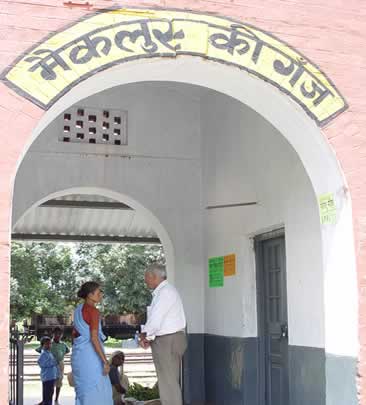|
The romance of a forgotten
Anglo-Indian summer  Photograph:
Preeti Verma Lal
Photograph:
Preeti Verma Lal
And then they came - the Mendis', the Christensens, the
Booths, the Bonners, the Camreroons….They bought acres
and acres of wild land, they built a church, a club, an
abattoir, a post office, a poultry farm and nice little
Anglican homes with flowers on the periphery and tiled,
slanted roofs. They brought their pianos, their horses and
their mahogany chests and teak four-poster beds. The sal
forest was suddenly agog with music, guffaws, the smell
of fresh meat, of rum cakes and tangy beer.
He stares
out of the frame - a strapping man, his sparse hair gelled
and combed back pleasingly, his black bow perched nattily
on a crisp white shirt; you can see the arrogance in his
eyes and you would conjecture he only mumbled monosyllables.
There are not many photographs of Ernest Timothy McCluskie,
this one is from the 1938 edition of The Skipper magazine.
You should know the man because if you see McCluskieganj
as a scratch on the map, it is only because E.T. McCluskie
contrived a dream.
During the tumult of the swadeshi movement
in the early 1930s, this rich businessman from Calcutta
got perked with an idea - he wanted to bunch together the
Anglo-Indians in a verdant hamlet and was looking for that
some place on earth. He found it nestled in the bountiful
sal forest of what was then the fiefdom of the Raja of Ratu,
a small principality not too far from Ranchi. He acquired
9,500 acres from the King for an undisclosed amount and
sent circulars to nearly 2,00,000 Anglo-Indians in India
inviting them to settle in this newly found place where
the jackals roamed, the river flowed silently and the forest
grew wildly. That was 1932.
And then they came - the Mendis', the
Christensens, the Booths, the Bonners, the Camreroons….They
bought acres and acres of wild land, they built a church,
a club, an abattoir, a post office, a poultry farm and nice
little Anglican homes with flowers on the periphery and
tiled, slanted roofs. They brought their pianos, their horses
and their mahogany chests and teak four-poster beds. The
sal forest was suddenly agog with music, guffaws, the smell
of fresh meat, of rum cakes and tangy beer. In the beginning
there were nearly 300 Anglo-Indian families. All was well
till 1946 and then just as they had come they left…
one by one, taking the train out of McCluskieganj station
and going wherever Fate took them.
But not everyone left. Kitty Teixeira's
grandfather luxuriating with a pension of Rs 112 a month,
chugged from Assam and bought 9.10 acres of isolated land
in McCluskieganj. He could have opted for London but he
chose to stay back and rear his rather large brood.
"I was born in McCluskieganj, I know no other world,"
says Teixeira as she holds on to a bag full of puffed rice
and haggles over the price of bananas in her basket. She
sells fruits at the McCluskieganj station and rambles between
impeccable English and the local dialect with a drawl. Kitty
is 56, porcelain skinned, brown eyes, her hair with naughty
curls and the colour of gold. Wiping the sweat on her blue
nylon saree that is carelessly draped on her rather fragile
casing, she wanders into a world that seems so lost and
forgotten now.
"There were no schools in McCluskieganj
but I remember wearing my Sunday best going to the church
and winning Rs 18 in a three-legged potato race and a tin
of pickles in a lucky dip," her voice fading into a
nostalgic whisper. "Oh! I also won Rs 6 at a fancy
dress competition where I dressed up as a paan-bidiwallah,"
she hurriedly adds.
Bryan Christensen was teaching in Calcutta
when his mother called him to McCluskieganj to look after
the family property. That was in 1963 and Christensen stayed
on, now running a hostel for students of Don Bosco Academy.
"When I came there were no macadamized roads, I actually
liked the dirt road; the people were friendly and the place
much more homely. Of course, things have changed…"
Tracy, his daughter, is happy in house that is stacked with
books and garden where the large magenta hibiscus grows.
McCluskieganj today is still as beautiful
as when the Anglos would punter on their horses and come
to the post office to pick mail or dance all night as the
gramophone kept churning melodious tunes and slung their
guns during Christmas parties (there were too many wild
animals then). Of the nearly 300 original settlers, only
20 families remain, others have been bought by rich brown
sahibs as summer homes. McCluskieganj changed when Alfred
de Rozario, an Anglo-Indian opened a branch of Don Bosco
Academy. A number of families now house boarders - might
sound incredible but there are 27 hostels in McCluskieganj.
There are tourist lodges and some houses still bearing marble
plaques carrying very British names.
Dr Alison Blunt, a geographer who teaches
in Queen Mary College in London, still remembers "the
beauty of the place and the warm hospitality of current
residents". She came to McCluskieganj to research for
her book Domicile and diaspora: Anglo-Indian women and the
spatial politics of home. There are others who come from
far off land looking for their ancestors - any trace, any
memory of them. McCluskieganj holds stacks loads of nostalgia
and history for them.
It is getting dark and as I get
ready to drive back, I notice Teixeira as she plays with
her curls and balances the basket of bananas sitting precariously
on her golden hair. She goes back to the fineries and joys
of a lost world, but the sound of an empty freight train
drowns her voice. You know tomorrow is not another day for
Kitty Teixeira. Yesterday was.
Published in Discover India
magazine, November 2005
|

